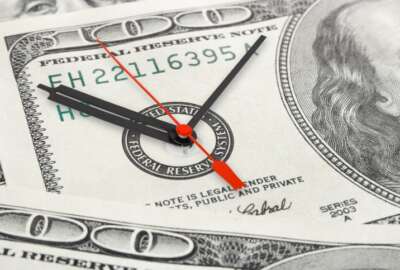
Status check: Your 2022 federal pay raise
So far there seems to be consensus at least within the White House and House on a 2.7% federal pay raise for civilian employees next year. But there's still one big...
The 2022 federal pay raise is coming into clearer focus.
In many ways the question that feds ask every year is certainly easier to answer than back in 2020. Sure, there are still plenty of questions about our pandemic or post-pandemic economy, but there’s no election drama to contend with. Feds will be done paying off that not-so-popular payroll deferral.
Things look relatively cut and dry this time on federal pay, but there’s still one, big lingering question.
I’ll get to that in a minute, but here’s what we know so far.
House appropriators were silent on the topic of federal pay in their 2022 draft legislation, which the financial services and general government subcommittee released and advanced last week.
It means the House has essentially endorsed President Joe Biden’s proposed 2.7% federal pay raise, and that number is likely what we’ll see as Congress hammers out next year’s budget.
Sure, the Senate could offer up its own number as it starts the appropriations process this summer, but it doesn’t seem likely. Rep. Jennifer Wexton (D-Va.) said the Senate is eyeing that 2.7% number too.
If Congress does nothing on federal pay between now and the rest of the calendar year, the president’s proposed federal pay raise for 2022 is almost bound to move forward. To make it official, Biden must sign an executive order implementing the raise for civilian federal employees before the year ends.
The EO, regardless of what it says, almost always comes near the holidays. Hopefully not on New Year’s Eve this time, please.
Congress can — as it has twice in the last three years — offer up and pass its own federal pay raise into law.
But again that seems unlikely, especially when the same party is in charge of the White House, House and Senate. There’s no real reason for the House or the Senate to break from the White House on this particular topic; there are seemingly bigger disagreements to settle.
Still, that hasn’t stopped federal employee groups from calling for something a little higher. A group of House and Senate Democrats introduced standalone legislation earlier this year, this time calling for a 3.2% federal pay raise in 2022. That’s what the two largest federal employee unions would like to see next year.
“Certainly the White House’s 2.7% proposal is a welcome start to the debate over what federal employees deserve next year, but there is plenty of time for the administration and Congress to reconsider and give frontline federal workers an average 3.2%,” Tony Reardon, national president of the National Treasury Employees Union, said last week.
Yes, there is still time.
And here’s where that lingering question comes back into play.
Federal pay raises usually come in two parts: a base pay raise and often a locality adjustment. For a full recap on how that works, check out these explainers from my colleague David Thornton and me.
When it comes to the president’s proposed 2.7% federal pay raise, the Biden administration hasn’t specified yet how locality adjustments fit into the picture.
Put another way, we don’t technically know whether 2.7% is the floor or the ceiling. When we asked the administration about it last month, an Office of Management and Budget official told us: “We are currently evaluating a number of options ahead of a final decision on the amount to be communicated to Congress in the president’s alternative pay plan.”
The White House has until the last day in August to send an alternative pay plan to Congress. But in the meantime, let’s speculate what some of those options could be.
Scenario #1: a 2.2% base pay raise + 0.5% locality adjustment = 2.7% total federal pay raise.
According to a formula set in statute, federal employees are, in fact, due a 2.2% base pay raise next year. Perhaps the Biden administration chooses to go along with that formula and tack on an extra 0.5% in locality adjustments.
Scenario #2: a 2.7% base pay raise + 0.5% locality adjustment = 3.2% total federal pay raise.
In this scenario, the 2.7% proposed raise is the floor, and it’s likely what federal employee groups are pushing while they seek bigger pay bumps for their members.
Yes, these numbers can change throughout the year. The previous two administrations have changed their minds before.
But if you’re the betting type, I’ll throw one caveat into the mix for this scenario. The military is also looking at a 2.7% pay raise next year. For some, maintaining pay parity between the military and civilian federal workforce is a priority.
Scenario #3: a 2.7% base pay raise, no locality pay adjustments.
It’s difficult to assess the likelihood of this one. But as feds might recall, there were no locality adjustments in 2021’s 1% pay raise.
This doesn’t mean feds don’t receive locality pay. It simply means locality pay levels are stuck at where they were back in 2019.
Scenario #4: none of the above! The scenarios I suggested above are educated guesses, based on both my experience with this topic and conversations that I’ve had with sources who track federal pay.
But of course, there are theoretically dozens of other options, and there’s nothing stopping the administration from mixing and matching other numbers.
So stay tuned throughout the summer; the federal pay picture will become even clearer by the end of August.
Nearly Useless Factoid
Tutankhamun’s tomb included his boomerang collection. They were traditionally used in ancient Egypt to hunt birds in the marshes.
Source: TourEgypt
Copyright © 2024 Federal News Network. All rights reserved. This website is not intended for users located within the European Economic Area.
Nicole Ogrysko is a reporter for Federal News Network focusing on the federal workforce and federal pay and benefits.
Follow @nogryskoWFED




